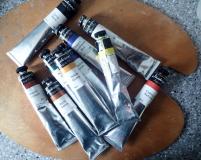|
Copyright is a tricky subject, and it’s important to know how to protect your own work as well as how to avoid exploiting someone else’s work.
Many artists copy the work of others at some time, whether they are amature or professional. It is a good way to develop technical expertise, and someone else’s painting or photograph may inspire you to try a new style or medium. This is fine, provided you don’t then publicise your version of that work or pass it off as your own, without crediting the original artist.
It’s a nuisance having to think about something like copyright when all you want to do is paint, but it is an issue that every artist needs to be aware of.
Here are a few basic rules to follow:
What is copyright?
There is no formal way of obtaining copyright in the UK, it just exists. Once you have created a work, the copyright for it belongs to you throughout your lifetime and for 70 years after your death. It is a good idea to sign your work to act as a record that you created it.
|
You can mark it with the international symbol, © followed by your name and the year, so anyone thinking of using it will know that you have claimed copyright. If you publish your art on a website you can make it harder for people to reproduce by keeping the images small and using a low resolution, or by watermarking them.
Using other people's work
You won’t infringe copyright if you use some one else’s work for private research or study- so you can copy a photograph, a picture from a book, or a painting by another artist, whether you’re working at home, at your local art club or visiting a gallery.
However if you decide to exhibit, publish or sell that painting, you are then benefiting financially, so you would need to seek permission from the artist or photographer who owns the copyright.
Even if you aren’t getting paid for your painting, you still can’t pass it off as your own. In the past SAA members have accidently infringed copyright by submitting work for the member’s gallery which has been copied from a photograph or another
|
artist's painting. Many artists learn to paint by using instruction books and DVDs. Always make sure that you credit other artists: so for instance you might title your work
"“ Country Lane” after a painting by A.N. Artist.”
Painting people or copying works of art
If you want to use a photo, the photographer holds the copyright, and if the photo was taken before the 1st August 1989 the copyright on it lasts for 70 year following the photographer’s death. However celebrities do not have ‘image rights’, so if a picture is in the public domain you can attempt a likeness of somebody using photographs in magazines. If you want to copy a famous work of art or sculpture, you won’t infringe copyright if the artist who did the original has been dead for more than 70 years. You can copy more recent work if it is for private use.
For more information about copyright visit www.dacs.org.uk the Design and Artist Copyright Society
|
